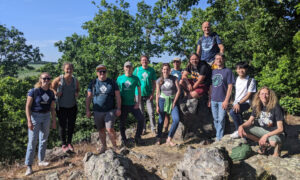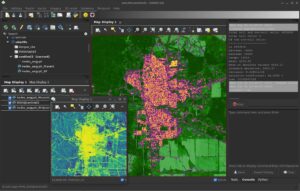The GRASS GIS 8.4.1 release provides more than 80 improvements and fixes with respect to the release 8.4.0. Enjoy!
The GRASS GIS 8.4.1RC1 release provides more than 70 improvements and fixes with respect to the release 8.4.0. Please support us in testing this release candidate.
Die Mailingliste grass-dev (GRASS GIS Development) wurde von Mailman auf die Discourse-Plattform von OSGeo umgestellt.
How to contribute to GRASS GIS development: Guidance for new developers in the GRASS GIS Project.
The GRASS GIS 8.4.0 release provides more than 520 improvements and fixes with respect to the release 8.3.2.
The GRASS GIS 8.4.0RC1 release provides more than 515 improvements and fixes with respect to the release 8.3.2. Please support us in testing this release candidate.
The GRASS GIS Annual Report for 2023 highlights a year of significant achievements and developments in the GRASS GIS project, which celebrated its 40th anniversary.
Here’s a summary of the report:
- Community Meeting: The GRASS GIS Community Meeting was held in June at the Czech Technical University in Prague, bringing together a diverse group of participants from various countries. Additionally, community members participated in the OSGeo Community Sprint in Vienna in November.
- Development Activity: The year saw the release of the GRASS GIS 8.3.0 feature release and three maintenance releases. There were 418 pull requests created, 387 merged, and 103 issues resolved. Nine new addons were added by several contributors. The top five contributors were acknowledged, and a new core contributor was welcomed. Also a GRASS Student Grant was awarded.
- Conferences in 2023: GRASS GIS was represented at several conferences, including the North Carolina GIS conference, FOSS4G in Kosovo and North America, and the OpenGeoHub Summer School. Topics covered ranged from parallelization in GRASS GIS to computational notebooks for geospatial computation.
- GRASS GIS in Industry: OpenPlains Inc., a startup utilizing GRASS GIS, was founded. Additionally, a subaward was granted to research software engineers at North Carolina State University to enhance GRASS GIS, funded by an NSF grant awarded to Natrx.
- GRASS GIS in Academia: A significant NSF grant was awarded to a team from four U.S. universities to support the GRASS GIS community. Various academic activities, including workshops, courses, and lectures, were conducted throughout the year, emphasizing the application of GRASS GIS in different fields.
- GRASS GIS in Government: The U.S. Geological Survey released a training video on using GRASS GIS with 3D Elevation Program data. The NC State University team received research support from the US Department of Agriculture for developing GRASS modules for surface water modeling.
Congratulations to all contributors!
The full report is available at https://grass.osgeo.org/news/2023_12_19_annual_report/
Markus Neteler
Open Source Consultancy
Get in touch
E-Mail: markus AT neteler DOT org | contact form



 Follow
Follow
 Follow
Follow